#black saddleback caterpillar
Explore tagged Tumblr posts
Photo
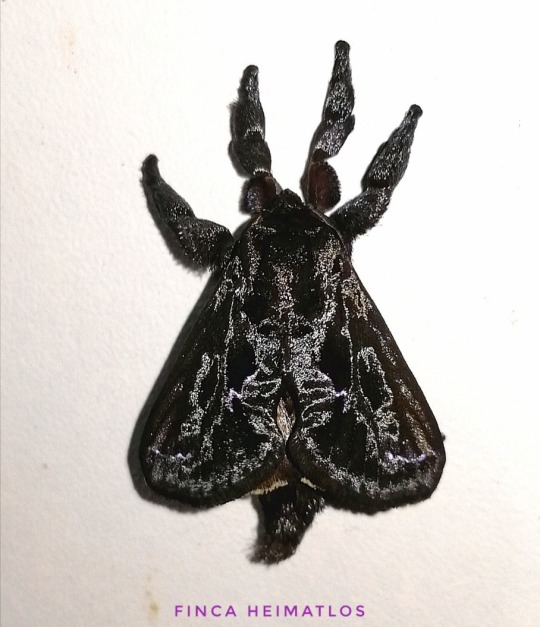
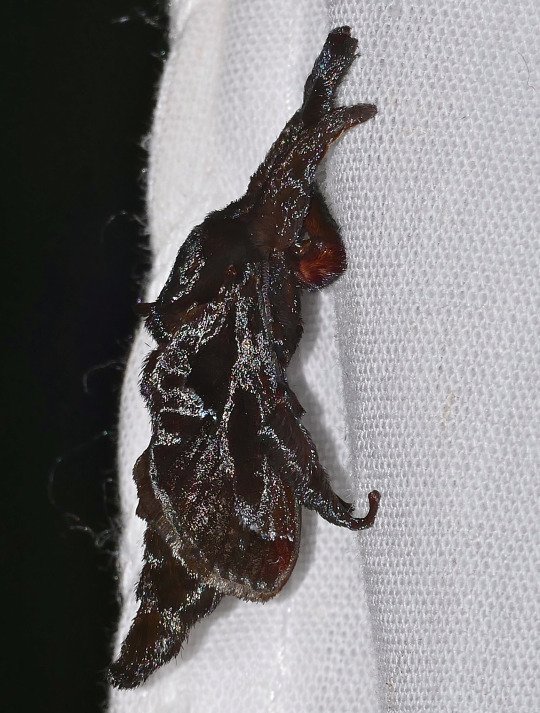

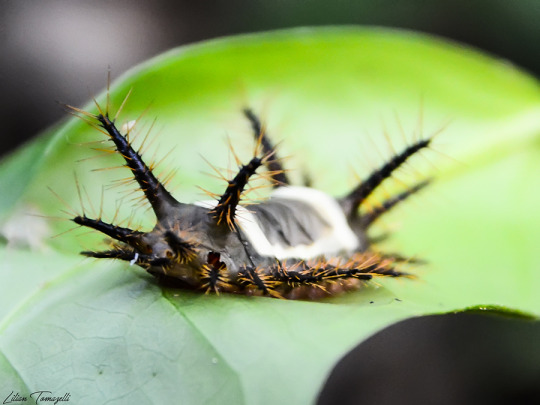
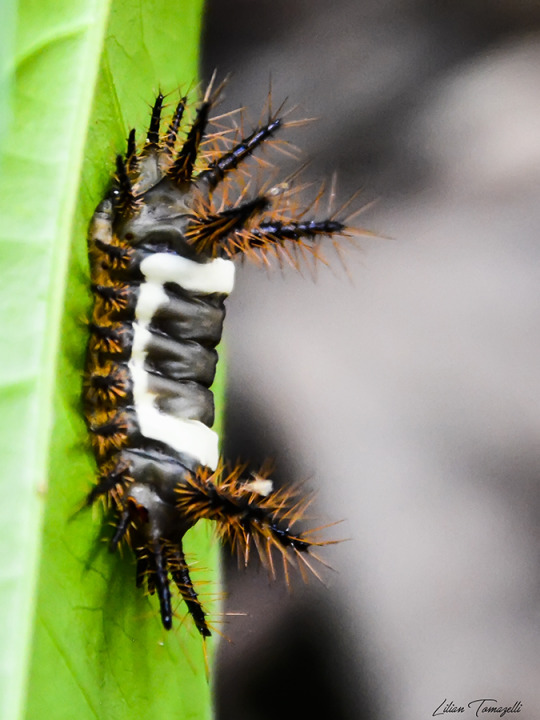
Black saddleback caterpillar moth, Acharia nesea, Limacodidae
Found in Central and South America
Photo 1 by heimatlos, 2 by berniedup, and 3-5 by lilatomazelli
#animals#curators on tumblr#insects#bugs#moth#caterpillar#larva#slug caterpillar moth#limacodidae#black saddleback caterpillar#black saddleback caterpillar moth#one nice bug#goth friend
1K notes
·
View notes
Text
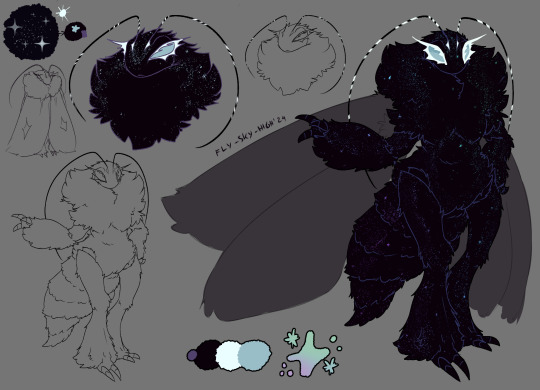
Self indulgent new OC I wanted to make after seeing the black saddleback caterpillar moth
A sparklemoth oc? kinda? XD This is Astraya (UPDATED and changed the name~
The scale shimmer is real for the most part, he also adds some on his own with glitter but not too much. Eyelashes are obviously fake but he makes them draw attention the most. If they accidentally fall of he gets upset because of it XD
I have yet to decide what to do with him, for now he's just a pretty boy, that's all!
134 notes
·
View notes
Text
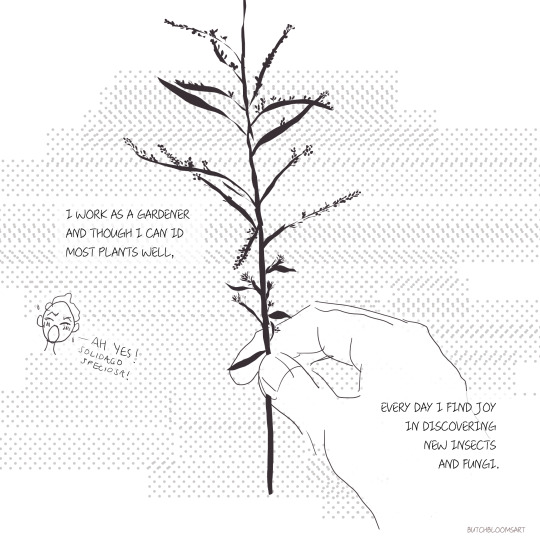
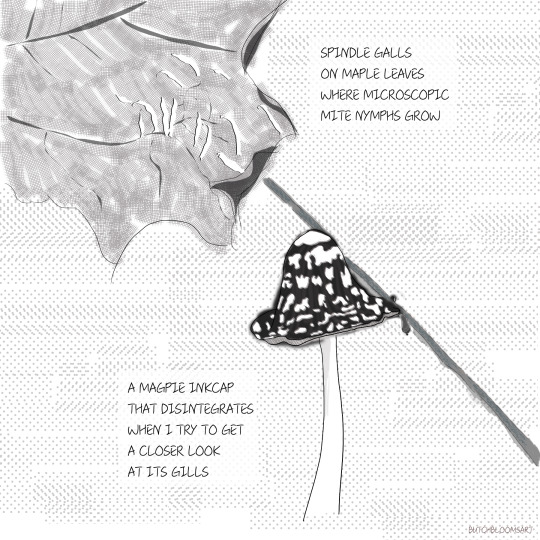
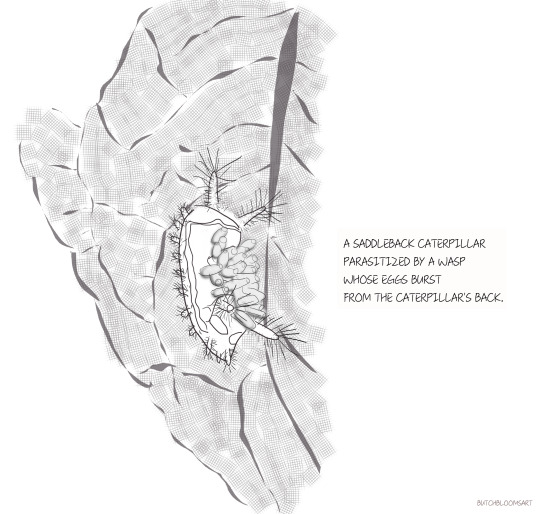
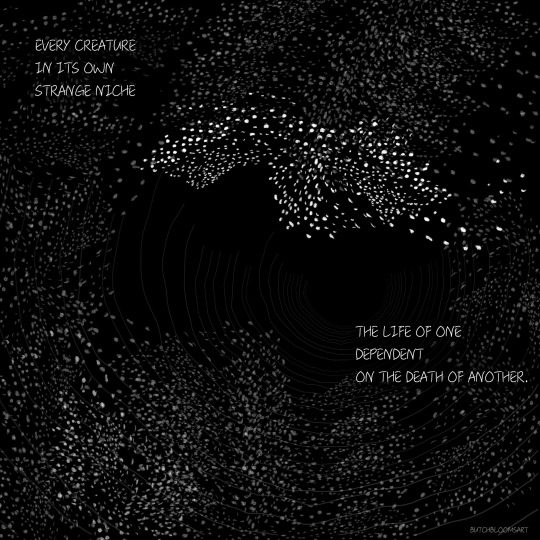
The first installment of my 2024 microcomic project! Planning to release a new one every 2-4 weeks.
[ID: A four-panel comic. The first panel is a white background with a black and white drawing of a hand holding a stem of goldenrod in bud. The text says, "I work as a gardener, and though I can ID most plants well, every day I find joy in discovering new insects and fungi." On the left side of the panel is a comic-y sketch of a person's face shouting, "Ah yes! Solidago speciosa!" The second panel is a white background with a black and white textured drawing of a maple leaf with a series of tall, thin galls rising from its surface. The text says, "Spindle galls on maple leaves where microscopic mite nymphs grow." Below, on the same panel, is a drawing of a mushroom, with a black hat covered in white splotches, and a stick resting against the mushroom. The text says, "a magpie inkcap that disintegrates when I try to get a closer look at its gills." The third panel is a white background with a textured black and white leaf underside. A saddleback caterpillar, with spiny antennae and feet, is on the leaf, and small oblong objects are clustered on its back. The text says, "A saddleback caterpillar parasitized by a wasp whose eggs burst from the caterpillar's back." The final panel is a black background with a matrix of white dots/stars arranged on it in waves. The text says, "Every creature in its own unimaginable niche, the life of one dependent on the death of another."]
#mine#my art#mycology#entomology#horticulture#digital illustration#comic art#insect art#plant art#garden art#gardening#microcomics2024#comics#art
8 notes
·
View notes
Note
hi i’m op of a post you reblogged i wanna hear some cool bug facts. i want to hear your bug knowledge please
OK. I won't lie I'm not a bug expert so these might seem basic, and are specific to where i live, but I will GLADLY share some with you oml
So, in my state of Florida, I unfortunately got stung by a puss caterpillar. I don't recommend it - it hurt so bad I thought my skin was burning, and my bones started hurting. Turns out, caterpillars can be poisonous! Also fun fact, we have several poisonous caterpillars (tussock moth, Saddleback and buck moth) and even poisonous trees (poisonwood and manchineel) but there are like no venomous spiders. Correlation? You're scared of the wrong thing.
Also fun fact (not even involving bugs) but north America has the wussiest venomous spiders. The brown recluse and the black widow seem scary but I'm more scared of the caterpillar. The spiders don't wanna bite you, they just wanna hang out :(
ALSO DID YOU KNOW THAT THERE IS A LEAF CRICKET??
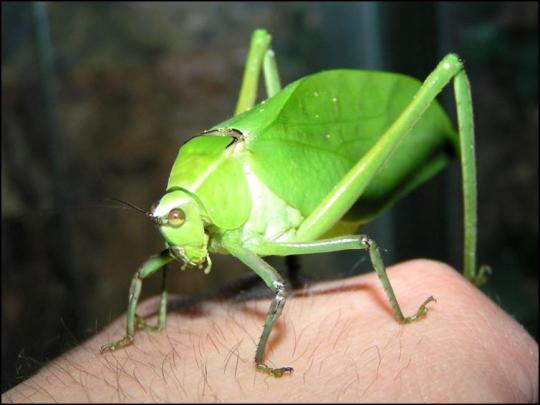
This is the Giant Florida Katydid and man do I love them...I don't see them that much anymore but leaf crickets <3
One last bug fact -> millipedes are NOT centipedes. Centipedes are very "flight or fight" and depending on the species would actually try to fight you, while milipedes curl up into a little ball and try to play dead if scared. Also milipedes look round and friendly while centipedes are sharp and mean. I think it's important to make the distinction
I have some more, but these are what I could think of for now lol.
#bugs are cool i mostly just observe them though#so for me its like the native species in my area#or whatever invasive species is becoming popular :(
6 notes
·
View notes
Text
30 September 2017: When I was younger, fall meant back to school. Now it means cool caterpillars.












#nj#nature#wildlife#insects#caterpillars#hickory horned devil#hickory tussock caterpillar#red-humped oakworms#saddleback#brown hooded owlet#yellow-haired dagger#smaller parasa#variable oakleaf caterpillar#laurel sphinx#black-waved flannel#turbulent phosphilas#white-blotched heterocampa
13 notes
·
View notes
Text
Slug caterpillars (Parasa indetermina) which live all the way north to the Rhode Island coast in the US by The Caterpillar Lab ●▬▬▬▬▬▬▬▬▬▬▬▬▬๑۩۞۩๑.▬▬▬▬▬▬▬▬▬▬▬▬▬● The black-tipped spines on the elongate body wall projections have poison glands at their bases. Venom enters the skin of humans or animals when the caterpillars are touched and the tips of the spines break off. The caterpillars are said to be capable of producing skin irritation similar to that produced by saddleback caterpillar, which is considered among the most severe urticating caterpillars in North America. Specialized irritating spines, called caltrop spines, are present on the lateral horns of several segments. This species is widespread in the forests of the eastern United States, but it is not particularly common. In fact, in some areas, such as New York State, it is considered a species of conservation concern. The adult moths, which have a wing span of about an inch, fly in early summer. Females lay eggs in July, and the eggs hatch in about nine days. Larvae tend to hide on the undersides of leaves. They mature around mid September. The species winters as a pupa inside a cocoon The weird caterpillars of the moth family Limacodidae are known as slug caterpillars. The head capsule is complete, but it is usually withdrawn and concealed in the prothorax. The thoracic legs are small, and the abdominal segments lack the fleshy prolegs found in most caterpillars. Instead, abdominal segments 1-7 and 10 have a single median sucker-like oval lobe that lacks spines or hooks.
#caterpillar#entomology#insect#insects#bug#bugs#cute insect#cute aesthetic#aesthetic#bug aesthetic#a e s t h e t i c
8 notes
·
View notes
Text
Please Don't Touch Hairy Caterpillars
Random PSA but-- Many fuzzy/hairy caterpillars are stinging and it will hurt like the devil himself came and slapped you if you touch them with your bare skin. If you need to relocate one, please use the paper/cup method, or grab a pair of gardening gloves. Seriously. Encourage kids to be cautious too. Caterpillars are really cool, but if you don't know what variety you're looking at, touching one bare handed is gambling on a bad time. Some stinging varieties from my neck of the woods: buck moth caterpillar

[ID: a Buck Moth Caterpillar: a long green speckled caterpillar that kind of resembles a skinny pickle with a bunch of little thorny branches sticking out of it. It's head and rear are a bright red orange] spiny oak slug caterpillar
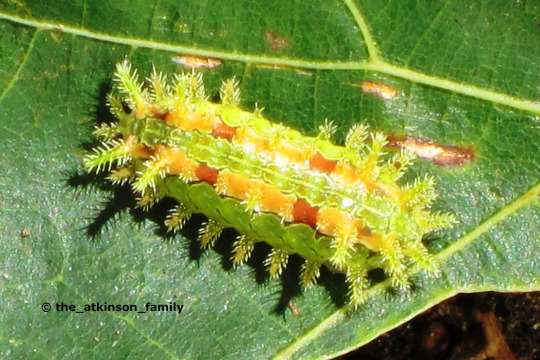
[ID: A spiny Oak Slug Caterpillar: A short, thick bodied bright green caterpillar with two orange stripes along its back. It has tree like spines all over it's body]
hickory tussock moth caterpillar
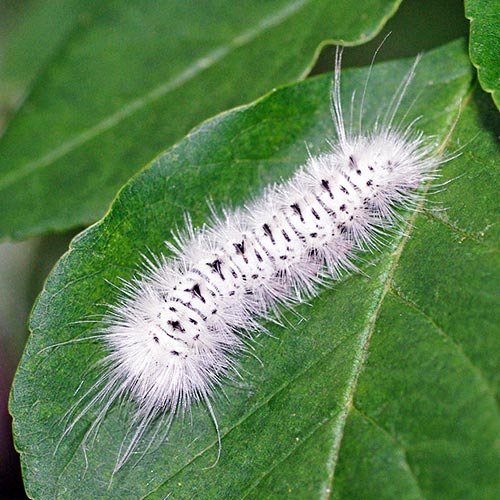
[ID: a hickory tussock moth caterpillar. It is a long fluffy white caterpillar with black flecks along it's body. The hairs at both ends of it's body are longer]
saddleback caterpillar
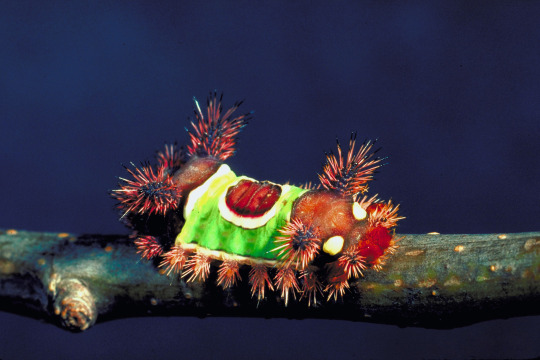
[ID: a saddleback caterpillar, it's head and rear are orange with two large spined antennae sticking out of them. It's middle is bright green with a red dot in the center and its lower body is ringed with small spiny appendages] io moth caterpillar
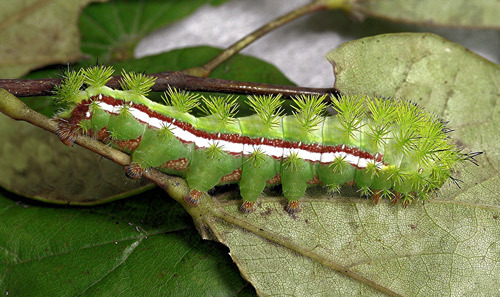
[ID: an io moth caterpillar. It is bright green with a long white and red stripe running along it's side. it's body is covered in bright green bristles. ] southern flannel moth caterpillar ( also known as the asp or puss caterpillar)--Seriously, these fuckers sting like the devil and I'm terrified of them ever since one fell on the inside of my skirt and I got stung in the leg.

[ID: A stinging asp/southern flannel moth caterpillar: a small extremely fluffy brown caterpillar. it's body is rounded on one end, the hairs on the other end come together into a little pointed tail] These fuckers also come in a pale white. Basically, if it looks like a little tiny ball of fur, *do not* touch it with your bare skin. They have the same venom some jellyfish do and while it isn't deadly or severe past "holy hell that throbs" most of the time, for some folks it can make you nauseous or cause breathing issues. They tend to fall out of trees, so check park benches and picnic tables before you sit so you can move them.
2 notes
·
View notes
Text
Can Dogs Eat Bugs?
https://www.centralparkpaws.net/wp-content/uploads/2020/02/IMG_7911-2-297x300.jpg
Maybe the better question is, is it safe for dogs to eat bugs?
Because I know all too well that yes, they can and will eat insects.
Of all of the dogs I’ve shared my life with, I have had two bug eaters. One grew out of it, and one still loves the little creepy crawlies.
Daisy was the first bug eater, but she was a puppy and only ate dragonflies.
She would snap at other bugs, but for whatever reason, she would eat the dragonflies.
I tried to get her to stop, and eventually, after she got sick from eating too many (BTW, so gross), she finally resisted the flying delicacies.
Ginger looking for the fly that was “bugging” her
However, Ginger has a less discernible palate when it comes to bugs.
Essentially, if it’s moving, she will eat it. Ginger doesn’t care if it stings, flies, or crawls.
Thankfully, she doesn’t eat them in mass quantity, so she hasn’t gotten sick, and somehow she hasn’t been stung.
But I imagine there are bugs out there that aren’t safe to eat, and since we travel with our dogs a lot, I thought I would try and see if there were any that I should watch out for, to ensure Ginger doesn’t mess with anything worse than a bee.
Why Do Dogs Eat Bugs?
The short, easy answer is: Because they are dogs.
The actual answer is that no one other than dogs knows why they are intrigued by moving critters, and likely curiosity gets the best of them.
Dogs explore their world differently than humans, and part of the way they take in the world is through their mouth.
There is no rhyme or reason as to why some dogs eat bugs and others do not.
Can Dogs Eat Bugs?
It depends on the bug and how much your dog chooses to eat.
Some insects are fine for the most part, whereas others are toxic or even venomous.
I have noted some of the more common bugs that dogs sometimes choose to dine on.
Bugs aren’t the only questionable food dogs want to eat. Click here to learn if dogs can eat waffles!
Can Dogs Eat Ants?
Most ants are safe for your dog to snack on, but some of the ants that sting, like fire ants, should not be treated as appetizers[1].
Fire ants will not only sting our dogs, but they often do so in large numbers.
A dog’s face and feet are the most likely areas that are affected by ant bites.
Symptoms your dog has eaten or tried to eat fire ants include:
Facial Swelling – Which can lead to breathing issues
Lameness – If your dog was bitten on their the feet or legs
Pale Gums
Pawing at their face or rubbing their face
In the event of an allergic reaction – Hives or Anaphylactic reaction
Vomiting
Drooling
Collapse or Weakness
Can Dogs Eat Cicadas?
Cicadas are not toxic, nor do they bite or sting.
If your pooch decides to try one of these crunchy creatures, the most significant risk is stomach upset.
However, if they find them to be tasty and eat too many, the exoskeletons can become an issue since they are difficult to digest.
Can Dogs Eat Flies?
Much like the ant, the common housefly is non-toxic and lacks a stinger.
However, there are more than just houseflies, and some of those like deer and horse flies have quite a bite.
Also, fireflies, though they don’t bite, they do contain a toxin called lucibufagin[2], which can cause dogs to become sick to their stomach.
Can Dogs Eat Caterpillars?
Not all, but many of the different types of caterpillars can be troublesome if not dangerous to eat.
Some of the caterpillars that will be more than just distasteful are:
Saddleback Caterpillar[3] – This caterpillar can be identified by its bright green torso, with a brown oval in the middle, giving it the look of a saddle. Also, it has spines all along its sides and horns, and the spines are poisonous.
Monkey Slug Caterpillar[4] – This caterpillar looks more like a giant hairy spider, but it is actually a hairy caterpillar. Whether or not the caterpillar’s hairs sting or not is debatable, but what is for sure is that this prickly menace can cause discomfort to your pup if eaten. The Monkey Slug can cause your dog to choke, drool, or gag.
Monarch Caterpillar – Because these caterpillars eat milkweed, they contain a toxin called cardenolides. Cardenolides can cause heart issues, including stopping the heart. The good news is that dogs often spit these critters out due to their bitter taste. The danger of eating these caterpillars extends to their butterfly form as well.
Puss Moth Caterpillars – If the name doesn’t warn you to keep your dog from eating this fellow, its venomous nature should.
And More – Other caterpillars to keep your dog away are Io moth, Gypsy moth, Buck moth, and Flannel moth.
Can Dogs Eat Cockroaches, Fleas, Beetles, Grasshoppers, and Crickets?
What do these five bugs have in common?
They all have the potential for carrying stomach worms, and when a dog eats any of these bugs, those worms can pass along to the dog.
Keep your dog from munching these pests if you can.
Can Dogs Eat June Bugs?
Though not toxic, June bugs consumed in large quantities can cause an upset stomach.
Thankfully, “you are what you eat” has limits
Can Dogs Eat Spiders?
It depends on the spider.
If the spider is a toxic or poisonous spider to us, then it isn’t one you want your dog eating.
Especially brown recluse and black widow spiders.
Can Dogs Eat Stink Bugs?
Though not toxic, due to the nasty taste, dogs have been known to experience minor adverse reactions such as drooling or even vomiting after eating stink bugs.
Can Dogs Eat Asian Lady Beetles?
You will want to keep your pup from dining on these multicolored beetles.
They can cause GI upset and even chemical burns in their mouth and GI tract.
If your dog consumes a large quantity, it can be fatal.
Is Eating Bugs Good for Dogs?
Though not all bugs are toxic, all bugs do carry a risk of coming in contact with pesticides, insecticides, and other chemicals that can cause your dog harm.
Eating one or two insects that carry harmful chemicals may not be an issue; however, excessive insect consumption could cause an adverse reaction.
What Are the Possible Dangers of Eating Bugs?
“Is this a snack?”
Even though some bugs may not be toxic, dogs can still have allergies to them.
Daisy was allergic to bee stings, and though she didn’t eat bees, she would snap at them from time to time.
We found out after she came in from playing in my mom’s garden that she had been stung and was having an abnormal reaction.
I rushed her to the emergency room, and they were able to help her. But, from then on, we had to always travel with an epi-pen.
So, in addition to the possible toxins, venoms, and stings, there’s always the possibility of an allergic reaction.
Another concern is if your dog consumes too many, and there is no set number to what that means, dogs can have issues with digesting the exoskeleton.
If a dog an abundance of bugs, they can end up with a bezoar, a hard mass that often requires surgical intervention.
The bezoar is the result of the non-digestible parts of bugs building up in your dog’s GI system.
How Many Bugs Can Your Dog Eat?
Snails may not be bugs but they can contain harmful parasites
Ideally, none.
But if your dog does a lot will depend on:
The size of your dog
The size of the bug
The type of insect
Some dogs could eat 5 ants no problem, but if they ate 5 June bugs they might be having some significant stomach issues later, so there is no set amount.
There are just too many variables.
Bugs aren’t the only “food” which may be fine in low amounts but can be bad for your dog when they eat too much. Coconut is another example!
Conclusion
Dog’s eat the craziest things, and though none of us want to be the helicopter dog parent, we do need to be cautious of what our dogs are putting in their mouths.
Because Ginger eats anything not nailed down, I have worked on the Off and Drop commands quite extensively.
So, if you have a dog like Ginger who thinks everything from the stuffing in toys to the bug crawling along the sidewalk looks like a potential snack, training will be the best way to keep your dog safe.
I know we can’t always be with our dogs every moment of every day, but it is a good idea to know what, if any, toxic or dangerous bugs reside in your area, just in case your pup decides to try a new all natural-style treat.
Resources
https://www.petmd.com/dog/parasites/how-identify-and-treat-ant-bites-dogs
https://silentsparks.com/2017/07/06/please-dont-eat-the-fireflies/
https://ugaurbanag.com/saddleback-caterpillars/
http://www.vetstreet.com/dr-marty-becker/will-my-dog-get-sick-if-he-eats-bugs?page=2
The post Can Dogs Eat Bugs? appeared first on Central Park Paws.
from https://www.centralparkpaws.net/faqs/can-dogs-eat-bugs/?utm_source=rss&utm_medium=rss&utm_campaign=can-dogs-eat-bugs
0 notes
Text
These Hideous Bugs Will Ensure You Won't Feel Safe In Your Own Home. They're Horrifying.
New Post has been published on https://kidsviral.info/these-hideous-bugs-will-ensure-you-wont-feel-safe-in-your-own-home-theyre-horrifying/
These Hideous Bugs Will Ensure You Won't Feel Safe In Your Own Home. They're Horrifying.
Every night, you may think that you’re safe in your own bed, tucked into freshly laundered sheets. The terrifying fact is, though, you’re not. Your bedroom doesn’t stop absolutely terrifying monstrosities from being born every day. (You probably think I’m kidding. I’m not.) Even more horrifying? Some of those monsters might just end up under your bed. That’s because those monstrous creatures are something so commonplace, you probably never think about them: bugs. There are more frightening insects, arachnids and otherwise in the world than you can even imagine. This list of horrifying bugs barely scratches the surface of the creepy-crawlies that exist around the world. (Guess which ones you can find in your own home.)
1.) Assassin Bugs: There are different species of these bugs; they attack their prey quickly and violently. They kill other insects by stabbing them with their sharp beaks and then inject enzymes into the prey. The enzymes soften the insides, allowing them to slurp it out.
2.) Cicadas: These “tree crickets” live underground and then, as they mature, make their way to the surface. They can produce sounds up to 120 decibels (louder than a concert). They hang out in, and die in, extremely large numbers/swarms.
Yuck.
3.) Giant Katydids: Although these bugs can make you cringe in every way possible, the hamster-sized katydids aren’t harmful to humans. You can even keep them as pets (if you’re brave like that). They’re more active at night and create songs, like crickets do.
4.) Botflies: These bugs kind of resemble a little bumblebee, but they are far more horrifying. Their larvae are parasitic, injected into unsuspecting hosts by infected misquitos. They burrow under an animal’s skin (or yours) until they painfully crawl out.
5.) Dobsonflies: Both males and females can grow to be up to 5 inches long. The males’ mandibles are actually so big, they are unable to harm humans. The females, however, can bite you and even draw blood. Adults can generally be found from late spring into the middle of summer, remaining near bodies of water. Where you will be on vacation.
6.) Japanese Giant Hornets: These suckers can grow to be 2 inches long and their stingers can be a quarter-inch long. Not only are they GIANT, but they are extremely aggressive and fearless.
7.) Africanized Honey Bee: These are “killer bees.” Their ancestors were European honey bees crossed with African honey bees. They’re aggressive and extremely protective of their hives. Being swarmed by these bees can kill you, or result in so many stings your organs shut down.
8.) Giant Orb-Weaving Spiders: This family of spiders is particularly terrifying. Many are poisonous and some are SO BIG, they can hunt and kill a snake for a snack.
Or a bird. There is no reason why you should go near one if you see it in the wild. You should, in fact, run.
9.) Titan Beetles: These giant bugs can be around 7 inches long and their pincers can snap a pencil in half… but they usually leave humans alone. If you bother it, though, it will attack you. The world’s largest beetle WILL attack you.
10.) Huntsman Spiders: These spiders are big. And, depending on where you live in the world, you can find them in your own home. It doesn’t use a web to catch its prey, it’ll actually use its unreasonably huge legs to chase down its food. Thankfully, it’s not poisonous.
11.) House Centipedes: That’s right, as in, YOUR HOUSE. They are harmless, but you can find them underneath cabinets, in closets and basically everywhere you wouldn’t want to find a disgusting centipede.
12.) Bullet Ants: Found in rainforests throughout Central America, their bite is so painful, you’ll feel like you’ve been shot. Plus, the pain lasts for 24 hours. An indigenous Brazilian tribe use gloves filled with these ants as a painful initiation ceremony.
13.) Jewel Wasps: This parasitoid wasp use cockroaches as a live food supply for its developing larvae. It attacks the cockroach, paralyzing it. Then, it injects venom into the roach’s head, preventing it from trying to walk. The wasp then turns it into a zombie nursery, by laying its eggs into its abdomen. Yikes.
14.) Puss Caterpillars: It may look cute, but this fuzzball is actually quite venemous. They are high in protein and slow moving, so they needed a defense mechanism: serious toxins. Do. Not. Pet. Them.
If you do touch one: You will experience “intense throbbing pain develops within five minutes of contact, with pain extending up the affected arm. Other symptoms may include headaches, nausea, vomiting, intense abdominal distress, lymphadenopathy, lymphadenitis, and sometimes shock or respiratory stress.”
15.) Stink Bugs: They may not bother humans (they prefer vegetation), but they will make you smell if you bother them too much. Even if you smash one, you’ll be plagued by his or her stink.
16.) Brahmin Caterpillar: You don’t think living nightmares exist? Well, you’re WRONG. These caterpillars look like a creation of Tim Burton, like tiny terrors, but they can’t harm you.
You’d think that their appearance is for camouflaging purposes, but they may just want to make sure you never sleep soundly again.
17.) Saddleback Caterpillars: Although they are cute (they have their own little saddles!), these bright bugs are venomous. Contact with their hairs causes a painful, swollen rash and sometimes nausea. The sting can feel like an electric shock.
18.) Cockroaches: These guys are extremely common… and can carry 33 types of bacteria, 6 kinds of parasites and 7 pathogens. They can go 45 minutes without breathing, live a month without food and they will eat hair, toenails, eyelashes and eyebrows.
19.) Japanese Mountain Leeches: You’d think most leeches live in water, but this one can hunt you on land. They are typically slow, but can somersault after any prey pretty quickly, or drop down from trees. They can chew through your clothing and the numbing agent they can inject you with will ensure you don’t feel them sucking on your blood.
20.) Giant Centipedes: These awful creatures can grow to be up to 15 inches long. Even better? It’s also poisonous. It can’t kill you, but you will need to go to the doctor. (The solution is to just avoid these nightmares entirely.)
21.) Joro Spiders: Unfortunately, this scary spider is poisonous. Its bite is similar to that of a black widow spider. They are so awful, they have existed in Japanese folklore as evil seducing demons.
22.) Giant Wetas: Found in New Zealand, this oversized bug is one of the largest and heaviest in the world. They typically don’t bother humans, aside from haunting our dreams.
23.) Giant Isopods: This isn’t from a science fiction movie. These giant isopods, although technically a crustacean, are still terrifying. They live in the oceans… but that doesn’t mean you’re safe.
24.) Giant Silkworm Moth Caterpillars: This terrifying caterpillar is actually responsible for several deaths a year. The tiny, fragile hairs it is covered with are full of potent toxins. Gangrene-like symptoms and internal hemorrhaging can occur as a result of this sting.
Stock up on your bug spray. Some of these are terrifying, but others can actually kill you. You never know what monster will be lurking at the foot of your bed, hiding in the folds of your sheets… so, good luck sleeping tonight! Share the horror with others by clicking on the button below. Misery halved is misery shared, right?
Read more: http://viralnova.com/horrifying-bugs/
0 notes
Photo

From National Wildlife Federation Photo of the Week; February 27, 2017:
Connecticut Wildlife
National Wildlife's 46th annual Photo Contest is now open! Check out some of our favorite photos from past National Wildlife photo contests. Each week we'll celebrate nature and wildlife from a different state. This week we're featuring Connecticut nature and wildlife!
Photo Above: Nature photographer Bob Bachand made this image of a juvenile Black-crowned Night-heron (Nycticorax nycticorax) in a nest on Chimon Island in Connecticut's Stewart B. McKinney National Wildlife Refuge using a Canon EOS Mark III with a 300mm lens and flash unit. Read National Wildlife's Bird of Myth and Elegance.

Conservation photographer Dennis Quinn writes, "Vivid and vibrant images capturing butterflies and moths often overshadow the beauty of the larval life-stage of Lepidopterans. Striking in their own right, caterpillars rival in brilliance even the most stunning butterflies." The Connecticut resident used a Nikon D7000 with a 105mm micro-lens to photograph this Saddleback Caterpillar (Acharia stimulea) in Plantsville, Connecticut.

Nature photographer Karen Chase took this photo of one of her backyard habitat "gardens filled with plants for butterflies, bee balm, and a peach tree that keeps the birds and squirrels happy." The Connecticut resident used a Canon Rebel T2i with a 70-300mm lens. Read National Wildlife's Gardening for Pollinators.

Photographer Dennis Quinn writes, "As a conservation biologist I often have opportunities to document some of the most imperiled species, in this case a beautiful hatchling Bog Turtle (Glyptemys muhlenbergii) which sadly may represent the final generation at this Connecticut study site." Quinn made this image using a Nikon D7000 with a 105mm micro-lens. Read National Wildlife's When the Best Offense is a Good Defense.

Vicky Marella writes about this Eastern Chipmunk (Tamias striatus), "This little guy visits our garden every day to fill up on a few seeds." The Connecticut resident used a Nikon 5200 with a 300mm lens to capture the moment. Read National Wildlife's Chipmunks: More Than Cute.

Conservationist Dennis Quinn writes, "A beautiful example of an insect specialist, the iridescence of the Dogbane Leaf Beetle (Chrysochus auratus), resulting from light reflecting off tiny angled plates covering the pigmented layer of the elytra (hardened forewing), make this species hard to miss." The photographer got this shot in Plantsville, Connecticut using a Nikon D7000 with a 105mm micro-lens. Read National Wildlife's Creating a Haven for Beneficial Bugs.

Photographer Laura Bush writes, "I was privileged to discover this Downy Woodpecker (Dryobates pubescens) nest hole in my backyard, and was able to take a series of photos in the spring of 2009." The Connecticut resident used a Canon 40D with a 55-250mm lens. Read Eight Wonky and Wonderful Woodpecker Adaptations.

Nature photographer Julie Carlson made this image after spotting an American Bullfrog (Lithobates catesbeianus) on a lily pad during a trail-hike near her Connecticut home using a Nikon D200 with a 300mm f/2.8 lens. She writes about the moment, "the way this frog is posed is priceless!" Read National Wildlife's Ten Tips to Give Frogs a Landing Pad.

Michael Olson snapped this photo of a Metallic Green Bee (Agapostemon sp.) collecting pollen from the anthers of a yellow lily in his Connecticut backyard habitat using a Konica-Minolta DiMage Z3 camera. Read National Wildlife's Being There for Bees.

Photographer Carrie Blackwood captured this scene in Connecticut's Silver Sands State Park just before the rain came. She writes, "I loved the stark contrast of the golden reeds and deep gray sky." The New Hampshire resident used a Canon EOS Rebel T3 with an 18-55mm lens on a tripod.

Victor R Quintanilla photographed a Monarch Butterfly (Danaus plexippus) enjoying the nectar of Butterfly Weed (Asclepias tuberosa) in his Connecticut backyard habitat using a Nikon D60 camera. Read National Wildlife's Peril at Journey's End.

Wildlife photographer Kathleen Wilkie was walking along the banks of Union Pond when she came upon this Muskrat (Ondatra zibethica) that had just climbed out from the pond and was munching on some clover, managing to get a handful of photos before it quickly scrambled back into the pond. The Connecticut resident used a Nikon D40 with a 50-500mm lens.

Doug German writes, "I was patiently watching an Osprey (Pandion haliaetus) on its perch, when it dove and landed not more than 30 feet from me. This was my first successful capture of such an act, so amazing!" The Connecticut resident used a Nikon D800 with a 300mm f/2.8 lens.

Photographer Robin Matterfis made this image of a Painted Lady (Vanessa cardui) on the Butterfly Bush (Buddleja sp.) she planted in her backyard habitat butterfly garden. The Connecticut resident used a Canon PowerShot G7 camera. Read National Wildlife's Catering to Butterfly Royalty.

Wildlife photographer Eric Larson was photographing warblers in a Burlington, Connecticut marsh when a curious Eastern Raccoon (Proycon lotor lotor) swam nearby to observe. The Connecticut resident used a Nikon D200. Read National Wildlife's Raccoons: A League of Their Own.

Photographer Laura Bush made this image of a Rose-breasted Grosbeak (Pheucticus ludovicianus) perched on a feeder in her Connecticut backyard habitat using a Canon 40D with a 55-250 lens, shooting from behind glass. Read tips from National Wildlife about how to photograph wildlife through a window.

Shari Lucas photographed this grasshopper on a Black-eyed Susan (Rudbeckia hirta) flower in her Connecticut backyard habitat using a Canon PowerShot camera.

Robert Caroti took this photo of a sneaky Eastern Chipmunk (Tamias striatus) while "sitting in the backyard, watching my 'squirrel-proof' feeder." The Connecticut resident used a Nikon D5100 with a 300mm lens. Read National Wildlife's Chipmunks: More Than Cute.

Nature photographer Andrey Antov made this portrait of a Ceanothus Silkmoth (Hyalophora euryalus) in the wild by placing a black background behind the moth. The Connecticut resident used a Nikon D200 with a 60mm micro-lens.

Amateur photographer Diederick Cannegieter made this image of sunset on the Housatonic River in Connecticut using a Panasonic Lumix DMC-FZ18K camera.

Andrew Gillen writes, "This Wild Turkey (Meleagris gallopavo) popped out of the ferns while I was photographing plant life." The Connecticut resident used a Canon EOS Rebel T3i camera. Read 12 unusual and fascinating facts about wild turkeys.
More from the National Wildlife Federation:
Connecticut Forest & Park Association
NWF Blogs about Connecticut
National Wildlife Federation's Northeast Regional Center
Nature's Witnesses: Powerful images of wilderness can inspire conservation.
Nature and Wildlife Photography Tips Center
0 notes